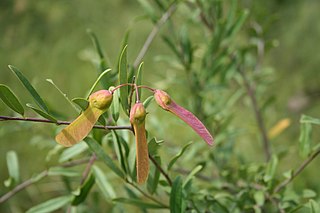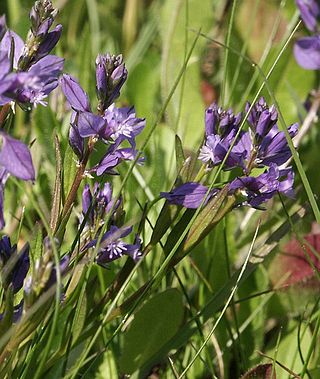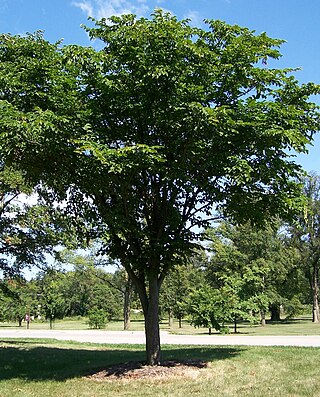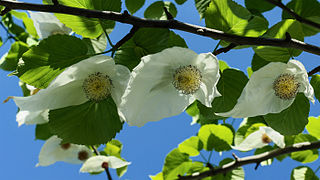
Magnolia is a large genus of about 210 to 340 flowering plant species in the subfamily Magnolioideae of the family Magnoliaceae. The natural range of Magnolia species is disjunct, with a main center in east and southeast Asia and a secondary center in eastern North America, Central America, the West Indies, and some species in South America.

The Polygalaceae or the milkwort family are made up of flowering plants in the order Fabales. They have a near-cosmopolitan range, with about 27 genera and ca. 900 known species of herbs, shrubs and trees. Over half of the species are in one genus, Polygala, the milkworts.
Conceveiba is a plant genus of the family Euphorbiaceae, first described as a genus in 1775. It is native to South America and Central America.
- Conceveiba guianensisAubl. - Brazil, Peru, Bolivia, Ecuador, Colombia, Venezuela, 3 Guianas
- Conceveiba hostmaniiBenth. - Guyana, Suriname, Amazonas State in Brazil
- Conceveiba krukoffiiSteyerm. - Venezuela, French Guiana, NW Brazil
- Conceveiba latifoliaBenth. - Colombia, Venezuela, Peru, Amazonas State in Brazil
- Conceveiba martianaBaill. - Venezuela, French Guiana, NW Brazil, Colombia, Ecuador, Peru, Bolivia
- Conceveiba maynasensisSecco - Loreto in Peru
- Conceveiba parvifoliaMcPherson - Panama, NW Colombia
- Conceveiba pleiostemonaDonn.Sm. - Costa Rica, Nicaragua, Colombia, Venezuela
- Conceveiba praealta(Croizat) Punt ex J.Murillo - NW Brazil
- Conceveiba ptariana(Steyerm.) Jabl. - S Venezuela
- Conceveiba rhytidocarpaMüll.Arg. - Colombia, Ecuador, Peru
- Conceveiba santanderensisJ.Murillo - NW Colombia
- Conceveiba terminalis(Baill.) Müll.Arg. - Venezuela, Guyana, Suriname, NW Brazil, Colombia, Peru
- Conceveiba tristigmataJ.Murillo - Colombia, Venezuela, NW Brazil

Polygala is a large genus of flowering plants belonging to the family Polygalaceae. They are commonly known as milkworts or snakeroots. The genus is distributed widely throughout much of the world in temperate zones and the tropics. The genus name Polygala comes from the ancient Greek "much milk", as the plant was thought to increase milk yields in cattle.

Chrysobalanaceae is a family of flowering plants, consisting of trees and shrubs in 27 genera and about 700 species of pantropical distribution with a centre of diversity in the Amazon. Some of the species contain silica in their bodies for rigidity and so the mesophyll often has sclerenchymatous idioblasts. The widespread species Chrysobalanus icaco produces a plum-like fruit and the plant is commonly known as the coco plum.

Alfred Rehder was a German-American botanical taxonomist and dendrologist who worked at the Arnold Arboretum of Harvard University. He is generally regarded as the foremost dendrologist of his generation.

Ulmus davidiana var. japonica, the Japanese elm, is one of the larger and more graceful Asiatic elms, endemic to much of continental northeast Asia and Japan, where it grows in swamp forest on young alluvial soils, although much of this habitat has now been lost to intensive rice cultivation.

Elmer Drew "E. D." Merrill was an American botanist and taxonomist. He spent more than twenty years in the Philippines where he became a recognized authority on the flora of the Asia-Pacific region. Through the course of his career he authored nearly 500 publications, described approximately 3,000 new plant species, and amassed over one million herbarium specimens. In addition to his scientific work he was an accomplished administrator, college dean, university professor and editor of scientific journals.

The dwarf wych elm cultivar Ulmus glabra 'Nana', a very slow growing shrub that with time forms a small tree, is of unknown origin. It was listed in the Simon-Louis 1869 catalogue as Ulmus montana nana. Henry (1913), referring his readers to an account of the Kew specimen in the journal Woods and Forests, 1884, suggested that it may have originated from a witch's broom. It is usually classified as a form of Ulmus glabra and is known widely as the 'Dwarf Wych Elm'. However, the ancestry of 'Nana' has been disputed in more recent years, Melville considering the specimen once grown at Kew to have been a cultivar of Ulmus × hollandica.

Ulmus laciniata var. nikkoensisRehder, the Nikko elm, was discovered as a seedling near Lake Chūzenji, near Nikkō, Japan, and obtained by the Arnold Arboretum in 1905. The taxonomy of the tree remains a matter of contention, and has been considered possibly a hybrid of U. laciniata and U. davidiana var. japonica. However, in crossability experiments at the Arnold Arboretum in the 1970s, U. laciniata, a protogynous species, was found to be incompatible with U. davidiana var. japonica, which is protandrous.

Macrolobium is a legume genus in the subfamily Detarioideae. It is a tropical genus with about 80 species. Half occur in Brazil, where they are common in the floodplains of the Amazonian Basin. Members of the genus are used as ornamentals and for their wood.

Parinari is a genus of plant in the family Chrysobalanaceae.

Amasonia is a genus of plants in the family Lamiaceae, native to South America and to the island of Trinidad.
Lily May Perry (1895-1992) was a Canadian-American botanist who worked at Arnold Arboretum and is most known for detailed compilation of information on medicinal plants of East and Southeast Asia and her assistance with the Flora of New Guinea. Perry also has the legacy of authoring the third highest number of land plant species among female scientists, in total naming 414 species.

Davidia involucrata, the dove-tree, handkerchief tree, pocket handkerchief tree, or ghost tree, is a medium-sized deciduous tree in the family Nyssaceae. It is the only living species in the genus Davidia. It was previously included with tupelos in the dogwood family, Cornaceae. Fossil species are known extending into the Upper Cretaceous.
Moutabea pacifica, synonym Balgoya pacifica, is a species of vine in the family Polygalaceae. It is endemic to New Caledonia. It has been considered to be the only species of the genus Balgoya. It is now placed in the neotropical genus Moutabea, in the tribe Moutabeae.
Carpolobia is a genus of plants in the milkwort family (Polygalaceae) that are native to tropical Africa and Madagascar. It was first written about in 1831 by George Don, at which point 4 species were identified. In 1849, the number of accepted species went down to 2. The other 2 became part of the legume family. The two species that remained, C. alba and C. lutea, were described as closely resembling each other. It was initially in the Polygaleae tribe before being split off in 1992 along with the genus Atroxima to form the new tribe of Carpolobieae.

Atroxima is a plant genus in the milkwort family (Polygalaceae). It is endemic to Western Tropical Africa. It was first described in 1905 by Otto Stapf in the Journal of the Linnean Society. It was initially in the Polygalaeae tribe before being split off with Carpolobia in 1992 to form the Carpolobieae tribe. They are lianas or liana-like shrubs which produce shiny, orange, fleshy uni- to tri-locular berries, these can have an area of up to 5 by 5 by 4 centimetres.
Gymnospora is a genus of plants in the milkwort family (Polygalaceae) which is endemic to Brazil. It was first described as a subgenus of Polygala by Robert Chodat in 1891. It was separated into its own genera in 2013. Their flowers are 6 to 10 millimetres long and its pedicels are 2 to 8 millimetres long.

Zanthoxyloideae is a subfamily of the family Rutaceae.














